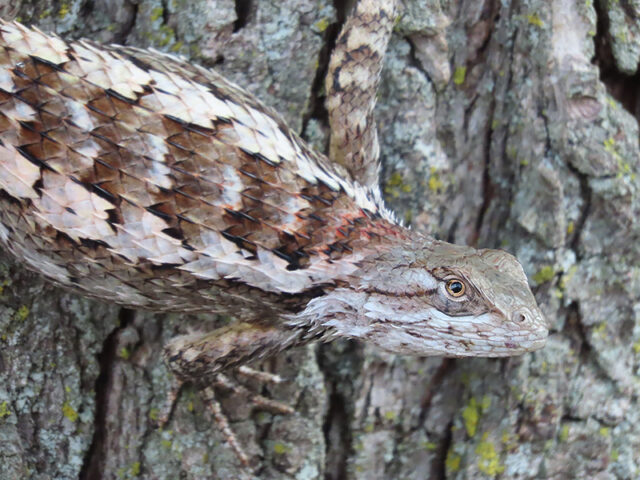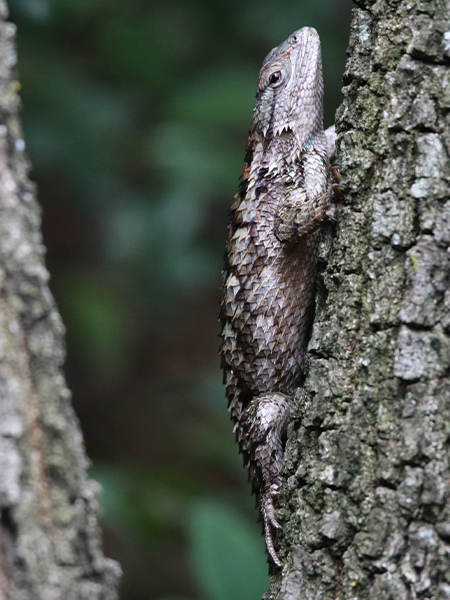Dateline – September 11, 2020 – Carrollton, Texas

We have a great many lizards the North Texas neighborhood we call home. It’s never hard to locate one with just a little bit of searching. Predominantly, there are two species to be found here—the diurnal Green Anole and the nocturnal Mediterranean House Gecko.
The anoles—which are active during the day—can be found in our bushes and in our trees. They have the delightful habit of changing colors from emerald green to dusky brown and then back again, as the mood strikes them.
Green Anoles breed all through the summer months, so it is not unusual to spy a hatchling from time to time. If I keep a sharp look out on our daily dog walks, I’m likely to spot at least one or two of the inch-and-a-half long baby lizards each week.


At night the geckos come out. They can often be found clinging upside down on the ceiling of our porch or patio waiting for the next moth to be drawn to our outdoor lighting.
The gecko population around our house was recently decimated by a pair of nesting Eastern Screech Owls. The owls preyed on the little lizards relentlessly in order to keep their hungry brood well feed. Beforehand, geckos were very numerous around our house, but for nearly two years afterwards they were seldom seen. This past season gecko numbers finally seem to be on the increase, and we are finding them with some regularity once again.
Geckos also breed during our summer months. They lay their eggs in detritus found in dry locations—often inside homes and other types of buildings. Several years ago I stumbled across a gecko egg while cleaning out a dusty corner of our garage. At the time, I wasn’t sure just what it was that I had discovered, so I put the little egg in a sealed container and waited to see what would happen.

It only took a couple of days for the egg to hatch, producing a miniature copy of an adult gecko, complete with big dark eyes, pink translucent skin, and a black and white striped tail. I took a few pictures and then sent the little guy on his way by releasing him on our front porch.

Mediterranean Gecko will sometimes lay their eggs communally—likely due to the particular suitability of the location in question. Below you will find a picture of one such nest. I took this picture in a friend’s country barn. The local geckos had found this unfinished portion of the barn’s wall especially to their liking. The nest contained well over 100 hatched gecko eggs. That amounts to a whole lot of little lizards!

Something New
It has only been for the last 5 years or so that I have been finding a third species of North Texas lizard in our neighborhood—the Texas Spiny Lizard.
I observe these rugged looking, brown, black, and gray lizards all around our subdivision these days. We have a particularly large 9-inch-long example living in our own backyard. She was observed noticeably gravid on several ocassions this summer.





Even though Texas Spiny Lizards have become quite common in our neighborhood, it was not until this past weekend that I found my first example of a hatchling. It would seem that we had an egg hatching event some time early Friday morning, because as I stepped out front to check the mail, I noticed several miniature Texas Spiny Lizards scurry away before me.
But they all didn’t run. One came to a stand still on the threshold of our front door. He was very tolerant, and I managed several photographs of him. I also noticed another baby spiny perched on the wood trim surrounding our landscaping beds. He also cooperated with me as I took several picture. You can see them all below…





Picture from Friends of Tandy Hills
Female Texas Spiny Lizards dig a hole in the ground as a place to lay their eggs. Soft, loose soil is preferable. Holes are typically large enough that the female can back herself in bodily in order to deposit her clutch. Afterwards the nest hole is covered, and the female leaves the eggs to be incubated. Under proper conditions the eggs will hatch approximately two months later.
Hopefully, our little Texas Spinys will soon find someplace safe to shelter. There are many predators in our neighborhoods who would gladly make a meal of one of these tiny guys. Birds, spiders, insects, toads, and even other lizards can all be expected prey on these vulnerable babies.

Blue Jay would be happy to make a meal of one
And while on the subject of baby critters, I have one more set of pictures to share with you. Earlier this summer I had the pleasure of watching this trio of Fox Squirrels horsing around in my backyard.
What we have here is a momma Fox Squirrels and her two not-ready-for-primetime offspring. Mom squirrel seemed to believe that it was way past time for her nearly grown babies to become more independent. The youngsters had other ideas, and stuck to her like glue. The poor over-taxed momma squirrel was seen running up and down all the trees in our backyard, trying to give her brood the slip, but the spry young squirrels had no trouble keeping up!





ready for her babies to become a little more independent…








I love the story of the squirrels!
Mama squirrel is definitely trying to wean her youngsters from nursing. Thanks for the lizard and squirrel stories!!